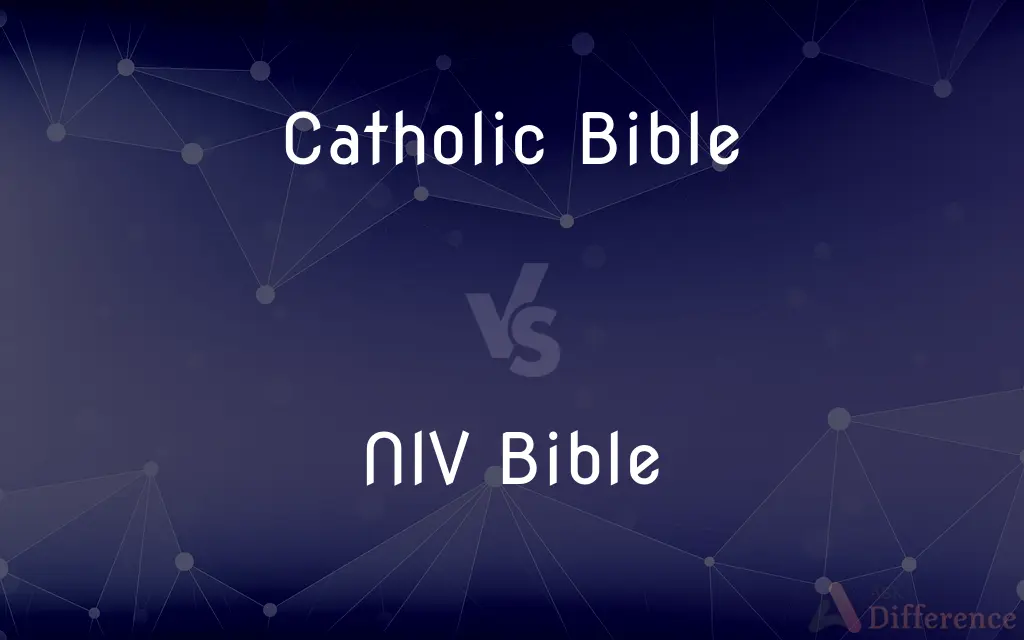Catholic Bible vs. NIV Bible — What's the Difference?
Edited by Tayyaba Rehman — By Urooj Arif — Published on March 8, 2024
The Catholic Bible includes seven additional books in the Old Testament, following the canon established by the Council of Trent. The NIV Bible, a popular Protestant version, focuses on a direct, accessible translation from original texts.

Difference Between Catholic Bible and NIV Bible
Table of Contents
ADVERTISEMENT
Key Differences
The Catholic Bible adheres to the canon established by the Council of Trent in the 16th century, which includes the Deuterocanonical books in the Old Testament. These books are Tobit, Judith, Wisdom, Sirach (Ecclesiasticus), Baruch, and 1 and 2 Maccabees, plus additions to Esther and Daniel. The NIV (New International Version) Bible, widely used in Protestant circles, excludes these books, adhering to the Jewish Tanakh's canon, which aligns with the Protestant Old Testament.
The NIV Bible, first published in 1978, aims for a balance between word-for-word and thought-for-thought translation philosophy, making it accessible and understandable for modern readers. The Catholic Bible's translation varies by version, with the New American Bible (NAB) and the Douay-Rheims Bible being prominent examples, each with a different translation approach.
The inclusion of the Deuterocanonical books in the Catholic Bible not only affects its size but also its application in liturgy, doctrine, and personal study. These books are considered inspired and canonical under the Catholic Church's teachings. In contrast, the NIV Bible, by excluding these books, reflects a different theological perspective and tradition.
Translation philosophy is another significant difference. The NIV Bible seeks to render the original texts into English in a way that balances accuracy with ease of understanding, often resulting in a more contemporary language. Catholic Bibles may follow a more formal equivalence approach or a dynamic equivalence approach, depending on the version.
The audience and usage of these Bibles also differ, with the Catholic Bible being used within the context of Catholic worship, education, and personal devotion, incorporating the Deuterocanonical books into its teaching and practice. The NIV Bible is popular among Protestants for its readability and is used in worship, study, and evangelism.
ADVERTISEMENT
Comparison Chart
Canon
Includes Deuterocanonical books
Excludes Deuterocanonical books
Translation Philosophy
Varies by version; formal or dynamic equivalence
Balance between word-for-word and thought-for-thought
Audience
Catholic Christians
Protestant Christians
First Published
Versions vary; Douay-Rheims (1609), NAB (1970)
1978
Use in Liturgy
Yes, includes books used in Catholic liturgy
No, tailored for Protestant worship and study
Compare with Definitions
Catholic Bible
Follows the canon established by the Council of Trent.
The Catholic Bible adheres to the Council of Trent's decisions on the canon.
NIV Bible
Excludes the Deuterocanonical books, aligning with the Jewish Tanakh.
The NIV Bible follows the Protestant canon.
Catholic Bible
Translation approach varies by version.
Different Catholic Bibles use different translation philosophies.
NIV Bible
Popular among Protestant denominations.
Many Protestant churches recommend the NIV Bible for personal study.
Catholic Bible
Versions include the New American Bible (NAB) and Douay-Rheims.
The NAB version of the Catholic Bible is widely used in America.
NIV Bible
Uses contemporary language for clarity.
The NIV Bible translates ancient texts into clear, modern English.
Catholic Bible
Includes seven Deuterocanonical books not found in most Protestant Bibles.
The story of Tobit is unique to the Catholic Bible.
NIV Bible
Aims for a balance between accuracy and readability.
The NIV Bible is known for its accessible language.
Catholic Bible
Used in Catholic worship and teaching.
The Catholic Bible is read during Mass.
NIV Bible
First published in 1978 to update the English translation.
The NIV was created to bring the Bible into contemporary language.
Common Curiosities
Why does the Catholic Bible include more books than the NIV Bible?
The Catholic Bible follows the Council of Trent's canon, which includes the Deuterocanonical books, reflecting differences in theological tradition.
Can Catholics read the NIV Bible?
Catholics can read the NIV Bible, but it lacks the Deuterocanonical books, which are part of Catholic doctrine.
What are the Deuterocanonical books?
They are books included in the Catholic Bible but not in the Protestant Bibles, like the NIV.
Do the Deuterocanonical books affect Catholic doctrine?
Yes, these books are integrated into Catholic doctrine and liturgical practices, influencing teachings on prayer, morality, and history.
Are there different versions of the Catholic Bible?
Yes, including the Douay-Rheims Bible and the New American Bible (NAB), each with different translation approaches.
Is the translation of the NIV Bible considered accurate?
The NIV Bible is respected for its balance between accuracy and readability, though translation accuracy is sometimes debated among scholars.
Which Bible is better for personal study?
"Better" depends on the reader's religious tradition and personal preference for translation style.
How often is the NIV Bible updated?
The NIV Bible has undergone several revisions to reflect contemporary language and scholarship, with the latest in 2011.
Is the NIV Bible used outside of Protestant circles?
While designed for Protestants, its readability makes it popular among some non-Protestant readers.
What version of the Bible do Catholics use in Mass?
In English-speaking countries, often the New American Bible (NAB) or translations approved by local bishops.
What is the main goal of the NIV Bible's translation philosophy?
To render the Bible into English that is both accurate to the original texts and understandable for modern readers.
Why was the NIV Bible created?
It was created to provide an accessible, accurate, and modern English translation of the original biblical texts.
What impact do the different canons have on Christian unity?
Differences in canon reflect deeper theological divisions but also represent the diverse ways Christians engage with sacred scripture.
How do the Deuterocanonical books influence Catholic practice?
They contribute to the richness of Catholic liturgy, prayer, and understanding of salvation history.
Can the NIV Bible be used in Catholic Mass?
The NIV Bible is not typically used in Catholic Mass due to the absence of the Deuterocanonical books and the need for Vatican-approved translations.
Share Your Discovery

Previous Comparison
Vitamin B1 vs. Vitamin B12
Next Comparison
Homogeneous Mixture vs. Heterogeneous MixtureAuthor Spotlight
Written by
Urooj ArifUrooj is a skilled content writer at Ask Difference, known for her exceptional ability to simplify complex topics into engaging and informative content. With a passion for research and a flair for clear, concise writing, she consistently delivers articles that resonate with our diverse audience.
Edited by
Tayyaba RehmanTayyaba Rehman is a distinguished writer, currently serving as a primary contributor to askdifference.com. As a researcher in semantics and etymology, Tayyaba's passion for the complexity of languages and their distinctions has found a perfect home on the platform. Tayyaba delves into the intricacies of language, distinguishing between commonly confused words and phrases, thereby providing clarity for readers worldwide.
















































